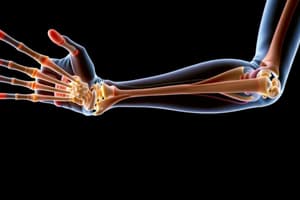Podcast
Questions and Answers
What type of reflex is the flexion reflex classified as?
What type of reflex is the flexion reflex classified as?
What is the primary role of the crossed extensor reflex?
What is the primary role of the crossed extensor reflex?
Which of the following best describes the pathway involved in a polysynaptic reflex?
Which of the following best describes the pathway involved in a polysynaptic reflex?
Which type of reflex involves involuntary responses to painful stimuli?
Which type of reflex involves involuntary responses to painful stimuli?
Signup and view all the answers
What activates nociceptors in the reflex pathway?
What activates nociceptors in the reflex pathway?
Signup and view all the answers
What type of reflex is involved when the foot is pulled away from a painful stimulus?
What type of reflex is involved when the foot is pulled away from a painful stimulus?
Signup and view all the answers
Which reflex helps maintain body stability when weight shifts away from a painful stimulus?
Which reflex helps maintain body stability when weight shifts away from a painful stimulus?
Signup and view all the answers
What is the main role of nociceptors in the reflex actions described?
What is the main role of nociceptors in the reflex actions described?
Signup and view all the answers
In the context of CNS integration, which pathway is activated by collateral signals following a painful stimulus?
In the context of CNS integration, which pathway is activated by collateral signals following a painful stimulus?
Signup and view all the answers
How do flexors and extensors respond during the crossed extensor reflex?
How do flexors and extensors respond during the crossed extensor reflex?
Signup and view all the answers
What is the primary function of nociceptors during a painful stimulus?
What is the primary function of nociceptors during a painful stimulus?
Signup and view all the answers
What type of reflex involves a direct route from sensory neuron to spinal motor neuron?
What type of reflex involves a direct route from sensory neuron to spinal motor neuron?
Signup and view all the answers
The withdrawal reflex is primarily an example of which type of reflex?
The withdrawal reflex is primarily an example of which type of reflex?
Signup and view all the answers
Which part of the nervous system is primarily involved in processing autonomic reflexes?
Which part of the nervous system is primarily involved in processing autonomic reflexes?
Signup and view all the answers
How does the central nervous system (CNS) integrate responses to a painful stimulus?
How does the central nervous system (CNS) integrate responses to a painful stimulus?
Signup and view all the answers
What emotional response can be associated with the experience of pain?
What emotional response can be associated with the experience of pain?
Signup and view all the answers
What happens during the flexion reflex in response to a painful stimulus?
What happens during the flexion reflex in response to a painful stimulus?
Signup and view all the answers
What role do primary sensory neurons play in reflex actions?
What role do primary sensory neurons play in reflex actions?
Signup and view all the answers
Study Notes
Reflex Responses to Painful Stimuli
- Flexion reflexes are polysynaptic reflexes that occur in response to painful stimuli, leading to immediate withdrawal from the source of pain.
- Nociceptors are sensory receptors that activate upon the detection of painful stimuli, initiating the reflex arc.
Mechanism of Flexion Reflex
- Upon activation of nociceptors, the sensory neuron sends signals to the spinal cord.
- The primary sensory neuron enters the spinal cord and diverges, activating:
- Ascending pathways for the perception of pain.
- Pathways for postural adjustments to maintain balance.
Crossed Extensor Reflex
- The flexion reflex in one limb causes opposing limb extension through the crossed extensor reflex, which aids in maintaining body posture and balance.
- When the reflex is triggered:
- The flexors of the affected limb contract to move away from the painful stimulus.
- Extensors of the opposite limb inhibit their contraction, allowing the extension necessary for weight support.
Functional Importance
- The flexion reflex serves as a protective mechanism, allowing rapid withdrawal from harmful stimuli.
- The crossed extensor reflex is critical for maintaining stability and balance during withdrawal, ensuring the body can reposition effectively after a painful experience.
Studying That Suits You
Use AI to generate personalized quizzes and flashcards to suit your learning preferences.
Related Documents
Description
This quiz covers the flexion reflex and the crossed extensor reflex as presented in neuroscience. It focuses on the neurological pathways involved, particularly the role of the spinal cord and ascending pathways to the brain. Test your understanding of these critical reflexes and their physiological processes.



